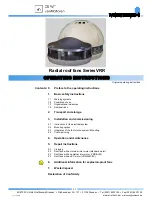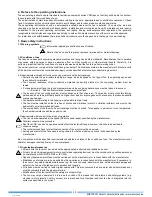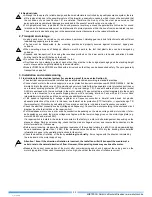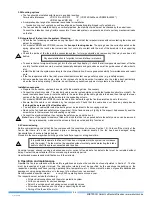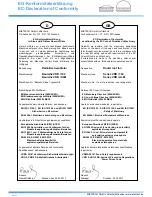
06
MIETZSCH GmbH Lufttechnik Dresden
s
www.mietzsch.de
6. Additional information for explosion-proof fans
Compliance with the conditions of use
is the basic requirement for explosion-proof state of a fan.
Ensure that the fan has an approval for the respective explosion zone conditions (zone, equipment group, equipment
class, explosion group, ignition temperature --> see the markings on the fan and the supplied documentation).
The following apply to fans fitted with motors with increased safety (EEx e):
permissible cooling air temperature -20 to +40 °C
permissible voltage tol/- 5%,
permissible frequency tol/- 2%
Integration of the fan into the system
In general, the fan should be installed so that it is protected against external mechanical loads. This particularly
applies at temperatures below -5 °C because the impact strength of plastics is reduced.
Measures must be implemented to prevent foreign matter falling in or being sucked into the fan and the motor cooling
fan. If necessary, safety devices, e.g. screens, must be installed in the system.
The air inlet connection must be gastight.
Modifications and attachments to the fan are only permissible after consultation with the manufacturer.
Before
commissioning
or start-up after a long downtime, carry out a thorough inspection of the fan. Any damage,
such as housing cracks, contact between the impeller and the housing, strong vibrations or noises, must be remedied
without delay Do not operate fans and motors if they are damaged.
Instructions for the electrical system / motor protection
(see also the operating instructions for the motor)
Requirements for the electrical connections:
Clearance distances between non-insulated parts > 10 mm.
Cable glands and sealing plugs must have an approval for explosion hazard zones
Reliable explosion protection of motors requires the installation of the correct motor protection system. Tripping
devices must have an ATEX approval.
Motors with increased safety (EEx e):
A motor protection device with a current-dependent delay and an ATEX approval must be installed so that, in the
event of an overload, it will disconnect the motor from the mains supply within the permissible heating period
(t
E
time). The motor can be additionally protected by a PTC thermistor. However, protection of the motor using only
a PTC thermistor is not permissible.
Motors with a flameproof enclosure (EEx de):
Motor protection devices with a current-dependent delay and/or PTC thermistors (TS) can be used.
Motors with increased safety (EEx e) do not have an approval for operation with a
frequency converter
.
Motors with a flameproof enclosure (EEx de) can be operated in conjunction with special temperature monitoring of
the converter with a PTC thermistor.
Inspection, maintenance and repairs
The fan must be inspected at regular intervals to maintain explosion protection and to recognise and remedy faults at
an early stage.
The inspection intervals are to be specified by the owner/user depending on the respective operating conditions
(soiling, operating time, temperature, etc.); however, after every 4,000 operating hours or every 6 months at the latest.
It is advisable to document these activities in writing.
Main points of inspection and maintenance work:
Cleaning of the housing, impeller and motor
Check of smooth running (imbalance) and motor bearing (noise, vibrations); relubricate, if necessary
Check that the impeller is rotating freely. Check the gap between the impeller and the housing
Check that all screwed connections are firmly secured and that connected components and flange connections
are gastight
Check the state of the shaft seal (particularly if the internal and external explosion zones are different)
Check the motor current and insulation resistance as well as the motor protection device
Check the state of the electrical connections
Check all other monitoring equipment
Work in potentially explosive atmospheres must be carried out with suitable and appropriately approved tools. It is
prohibited to open the terminal box when the fan is operating. All work on the fan should thus be carried out in a non-
energised state and only if the possibility of a potentially explosive atmosphere can be excluded.
Plastic parts must be cleaned with damp agents to avoid electrostatic charges.
Repairs of explosion-proof fans must be carried out by the manufacturer or in consultation with the manufacturer.
7. Waste disposal
MIETZSCH fans are built to last. Thus disposal issues only crop up after many years of operation. The individual
components are not regarded as hazardous waste according to current legislation.
Dispose of metal components (base, motor, screws, etc.) in the usual manner
Clean plastic components and then dispose of them as normal waste
The owner/user must dispose of residual materials and deposits in the fan in an environmentally acceptable manner.
oi_vrr (11/09)

